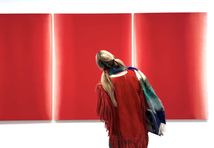Gwen John: Art and Life in London and Paris Exhibition Review
- The Courtauldian
- Nov 9, 2023
- 3 min read
Gwen John: Art and Life in London and Paris Exhibition Review
In the same decade that Rodin produced The Thinker (1904) and Matisse The Dance (1910), Welsh-born artist Gwen John produced The Courtyard Room (1907-8), a similar meditative study of the human spirit. Despite her connection to these canonical artists and shared investment in modernism, John’s name has been lost in the events of the twentieth century. Gwen John: Art and Life in London and Paris aims to refocus the artist’s impressive 40-year career through a chronological examination of her artwork. Previous attempts to rationalize John’s contributions to the art world have dismissed her as a recluse and closed figure, rather than acknowledge her quieted position as the result of a male-dominated field. The exhibition not only highlights John as an important artist and interlocutor in transnational modernism, but sheds light on a network of female artists who sustained these important dialogues in their own coterie.
Art historian and curator, Alicia Foster, traces John’s chronological passage, beginning with John's education at both the Slade school of art, and Académie Carmn under the tutelage Whistler. The exhibition then explores the relationship John had as lover and model of Rodin, before concluding with her conversion to Catholicism and portraiture of nuns. John’s portraits of solo women dominate the exhibition, sometimes engaging the viewer, often poised in three-quarter profile, and always composed in a disquieting reverie. The curious technique that John employed of mixing chalk with acrylic paint, elevates the textural quality of the canvas adding dimension to the flat, monochromatic backgrounds.
Perhaps my favorite component of the exhibition is a ready appreciation for John’s love of cats. Throughout the exhibition, visitors are introduced to one of the artist’s beloved pets, Edgar Quinet, who she adopted with her friend and cohabitor, Dorelia McNeill. One of the two introductory paintings is a portrait of an unknown woman in three-quarter profile with her arms circling a black cat. The tender embrace acts as a stark contrast to the subdued greys of the background and her solemn blue dress. Completed after the First World War, the interior gloom perhaps references what the sitter witnesses from an unseen window of a bombed and equally gloomy Paris. Foster, in her biography of John, connects the painting to contemporary interests of posing women with cats, as seen in Pierre Bonnard’s painting entitled The Bowl of Milk (1919) and thus placing her amongst the modernist milieu.
In an interesting juxtaposition, cats appear later in the exhibition on a wall shared with drawings by Rodin and John. Foster acknowledges that “cats are a cliché of spinster life, often seen as a sentimental and second-rate subject for art (particularly when women paint them).” Their soft curves and gestures of dynamic movement are compared to the overtly sexualized sketches by Rodin, particularly Les Femmes Damnées (The Damned Women) which may have been John and another of Rodin’s models, Hilda Flodin. The flurry of the pencil strokes crescendos into chaos obscuring the women’s faces and rendering them unimportant. This stands in direct contrast to John’s sensitive treatment of women, especially in detailing their unsettling expressions, seen throughout the exhibition. However, by juxtaposing Rodin’s sketches to John’s sketches of cats, Foster elevates a previously diminished and stereotyped image to that of the nude, a culturally coded subject deemed appropriate in the hands of the male artist. Both show the skill of the artists, but underscore John’s painterly abilities in contrast her lover’s more two-dimensional eroticism of the female body, especially of her own.
As is often the case for recuperative projects such as this, the exhibition relies heavily on a historical intervention, providing an introductory timeline and focusing the wall texts and visitor progression on chronological rather than thematic parameters. It is therefore helpful to circle through the exhibition at least twice, once to acquaint oneself with the biographical details and a second to notice the rich, subtle nuances.
The exhibition is traveling from Chichester to Bath where her collected works will be on display at the Holburne Museum from 21 October 2023 through 14 April 2024. Situated amongst the museum’s important European collection, John’s work will undoubtedly foster a rich dialogue around women artists’ visibility within cultural institutions and acquaint audiences with her poignant reflections on interior spaces, both metaphysical and domestic.
Images

















Comments